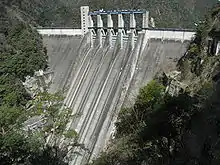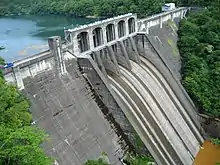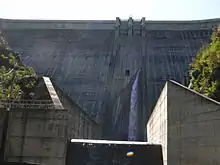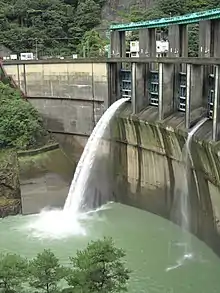Hydroelectricity in Japan
Hydroelectricity is the second most important renewable energy source after solar energy in Japan with an installed capacity of 50.0 gigawatt (GW) as of 2019.[1] According to the International Hydropower Association Japan was the world's sixth largest producer of hydroelectricity in 2020. Most of Japanese hydroelectric power plants are pumped-storage plants. Conventional hydropower plants account for about 20 GW out of the total installed capacity as of 2007.[2]
Conventional hydropower potential of Japan is considered to be almost fully developed, with little opportunity for further capacity increase.[3] In recent years, almost exclusively pumped storage plants were commissioned, significantly increasing the ratio of pumped storage capacity over conventional hydro.[3] The large capacity of pumped storage hydropower was built to store energy from nuclear power plants, which until the Fukushima disaster constituted a large part of Japan electricity generation. As of 2015, Japan is the country with the highest capacity of pumped-storage hydroelectricity in the world, with 26 GW of power installed.[4] After the 2011 nuclear power shutdowns, pumped-storage plants have been increasingly used to balance the variable generation of renewable energy sources such as solar, which have been growing rapidly in recent years.[4]
As of September 2011, Japan had 1,198 small hydropower plants with a total capacity of 3,225 megawatt (MW). The smaller plants accounted for 6.6% of Japan's total hydropower capacity. The remaining capacity was filled by large and medium hydropower stations, typically sited at large dams. Cost per kilowatt-hour for power from smaller plants was high at ¥15-100, hindering further development of the energy source.[5]
List of hydroelectric power stations




| Station | Capacity (MW) | Prefecture | Coordinates | Status | Type |
|---|---|---|---|---|---|
| Akiba Dam | 127.1 | Shizuoka | 34°58′20″N 137°49′42″E | Operational | pumped storage |
| Amagase Dam | 92 | Kyoto | 34°52′51″N 135°49′41″E | Operational | conventional |
| Arimine Dam | 534 | Toyama | 36°29′22″N 137°26′55″E | Operational | conventional |
| Dashidaira Dam | 124 | Operational | |||
| Funagira Dam | 32 | Shizuoka | 34°53′26″N 137°48′54″E | Operational | |
| Hatanagi-I Hydroelectric Dam | 137 | Shizuoka | 35°19′17″N 138°10′59″E | Operational | pumped storage |
| Hatanagi-II Hydroelectric Dam | 85 | Shizuoka | 35°18′29″N 138°12′11″E | Operational | pumped storage |
| Hiraoka Dam | 101 | Nagano | Operational | ||
| Honkawa[6] | 600 | pumped storage | |||
| Ikawa Dam | 62 | Shizuoka | 35°12′38″N 138°13′22″E | Operational | |
| Ikehara Pumped Storage Plant | 350 | Operational | pumped storage | ||
| Imaichi Pumped Storage Plant | 1,050 | Tochigi | 36°49′31″N 139°39′58″E | Operational | pumped storage |
| Kadonogawa Power Station | 800 | Operational | pumped storage | ||
| Kannagawa Hydropower Plant U/C | 2,820 | Nagano | 36°00′18″N 138°39′09″E | Operational | pumped storage |
| Kazunogawa Pumped Storage Plant | 1,200 | Yamanashi | 35°43′07″N 138°55′47″E | Operational | pumped storage |
| Kinugawa-Kurobe Dam | 127 | Operational | |||
| Kisenyama Pumped Storage Plant | 466 | Kyoto | 34°53′30″N 135°51′34″E | Operational | pumped storage |
| Konoyama Dam | 126 | Niigata | Operational | ||
| Kurobe Dam | 335 | Toyama | 36°33′30″N 137°40′00″E | Operational | |
| Kuroda Dam | 315 | Aichi | 35°11′14″N 137°28′34″E | Operational | |
| Maruyama Dam | 185 | Gifu | 35°28′08″N 137°10′20″E | Operational | |
| Matsubara Dam | 50.6 | Oita | 33°11′39″N 130°59′38″E | ||
| Masegawa Dam[6] | 288 | Operational | |||
| Matanoagawa Pumped Storage Plant | 1,200 | Tottori | 35°14′44″N 133°29′30″E | Operational | pumped storage |
| Miboro Dam | 215 | Gifu | 36°08′17.7″N 136°54′38.9″E | Operational | |
| Midono Pumped Storage Plant[6] | 122 | Operational | pumped storage | ||
| Miho Dam | 7.4 | Kanagawa | 35°24′37″N 139°02′30″E | Operational | |
| Misakubo Dam | 50 | Shizuoka | 35°11′05″N 137°55′54″E | Operational | |
| Miyagase Dam | 24 | Kanagawa | 35°32′26″N 139°15′09″E | Operational | |
| Miyanaka Dam | 449 | Niigata | Operational | ||
| Nagano Pumped Storage Plant | 220 | Operational | pumped storage | ||
| Niikappu Pumped Storage Plant | 200 | Operational | pumped storage | ||
| Nishiotaki Dam | 234 | Nagano | Operational | ||
| Numappara Pumped Storage Plant | 675 | Operational | pumped storage | ||
| Ohashi Dam | 615 | Kōchi | 33°46′13″N 133°20′12″E | Operational | pumped storage |
| Ōigawa Dam | 68.2 | Shizuoka | 35°09′53″N 138°08′34″E | Operational | |
| Okawachi Pumped Storage Power Station[7] | 1,280 | Hyōgo | Operational | pumped storage | |
| Okukiyotsu Pumped Storage Power Station (1 & 2) | 1,600 | Niigata | Operational | pumped storage | |
| Okinawa Yanbaru Seawater Pumped Storage Power Station[8] | 30 | Okinawa | 26°40′25″N 128°15′56″E | Operational | pumped storage |
| Okutadami Dam | 560 | Niigata/Fukushima | 37°09′12″N 139°15′00″E | Operational | conventional |
| Okutataragi Pumped Storage Plant | 1,932 | Hyōgo | 35°14′12″N 134°51′23″E | Operational | pumped storage |
| Okuyoshino Pumped Storage Plant | 1,206 | Nara | 34°7′4″N 135°49′16″E | Operational | pumped storage |
| Otori Dam | 182 | Fukushima | 37°12′53″N 139°12′50″E | Operational | |
| Sagami Dam | 31 | Kanagawa; | 35°36′56″N 139°11′43″E | Operational | |
| Sakuma Dam | 350 | Aichi | 35°05′58″N 137°47′39″E | Operational | conventional |
| Sasamagawa Dam | 58 | Shizuoka | 34°58′17″N 138°05′38″E | Operational | |
| Senzu Dam | 22.2 | Shizuoka | 35°13′00″N 138°05′25″E | Operational | |
| Shimogo Pumped Storage Power Station | 1,000 | Fukushima | Operational | pumped storage | |
| Shin-Takasegawa Pumped Storage Plant | 1,280 | Nagano | 36°28′26″N 137°41′23″E | Operational | pumped storage |
| Shinanogawa Pumped Storage Plant | 234 | Operational | pumped storage | ||
| Shintoyone Pumped Storage Plant | 1,125 | Aichi | 35°07′33″N 137°45′38″E | Operational | pumped storage |
| Shiobara Pumped Storage Plant | 900 | Tochigi | Operational | pumped storage | |
| Shiogō Dam | 58 | Shizuoka | 35°00′05″N 138°05′15″E | Operational | |
| Shiroyama Dam | 275 | Kanagawa | 35°35′09″N 139°17′22″E | Operational | |
| Tagokura Dam | 390 | Fukushima | 37°18′38″N 139°17′13″E | Operational | |
| Takami Pumped Storage Plant | 200 | Operational | pumped storage | ||
| Taki Dam | 92 | Fukushima | 37°23′13″N 139°32′02″E | Operational | |
| Tamahara Pumped Storage Power Station | 1,200 | Gunma | 36°46′56″N 139°03′23″E | Operational | pumped storage |
| Tashiro Dam | 40.1 | Shizuoka | 35°29′55″N 138°14′47″E | Operational | |
| Tedorigawa I Dam | 250 | Operational | |||
| Tokuyama Dam | 153 | Gifu | 35°39′55″N 136°30′08″E | Operational | |
| Okuyahagi Pumped Storage Power Station | 1,160 | Gifu | 35°11′59″N 137°27′31″E | Operational | pumped storage |
| Yagisawa Pumped Storage Plant | 240 | Operational | pumped storage | ||
| Yomihaki Power Station | 112 | Operational |
See also
| Wikimedia Commons has media related to Hydroelectric power plants in Japan. |
References
- "Status of Hydropower in Japan - May 2007" (PDF). New Energy Foundation. Archived from the original (PDF) on 28 July 2017. Retrieved 15 July 2017.
- "ELECTRICITY REVIEW JAPAN 2015" (PDF). The Federation of Electric Power Companies of Japan. Retrieved 15 July 2017.
- Fairley, Peter (18 March 2015). "A Pumped Hydro Energy-Storage Renaissance". IEEE Spectrum: Technology, Engineering, and Science News. Retrieved 23 October 2017.
- Johnston, Eric, "Small hydropower plants keep it local", Japan Times, 29 September 2011, p. 3.
- "Pumped-Storage Hydroelectric Plants in Japan - Industcards". Archived from the original on 2013-01-03. Retrieved 2013-05-03.
- Major Power Plants in Japan
- Yanbaru Archived 2007-08-04 at the Wayback Machine
